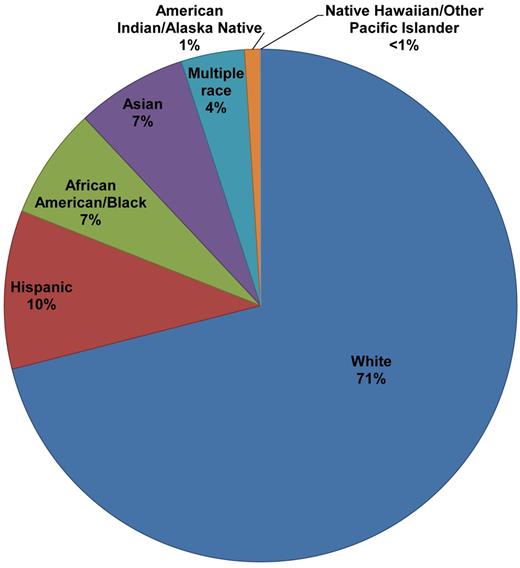In this issue of Blood, Switzer and colleagues report results from a phone survey of 1067 people called on by the National Marrow Donor Program (NMDP) as potential donors because they were preliminary matches with patients in need of a transplant.1 The study found that people who do not proceed with donation tend to be younger and have lower socioeconomic status, worse self-reported health, and more concerns about donation. The greatest predictor of opting out of donation was high ambivalence. Switzer et al suggest ways that donor ambivalence could be minimized, in hopes of increasing the likelihood of potential donors proceeding with donation.
Hematopoietic cell transplantation from a fully HLA-matched donor is associated with better survival than transplantation from a donor with 1 or more HLA-mismatches.2,3 Despite a registry of 10 million potential donors maintained by the NMDP (see figure), the odds of finding a fully matched donor differ considerably based on the race and ethnicity of the recipient (Stephen Spellman, NMDP, written communication, January 3, 2013). If 10 white people search the NMDP registry, 8 will locate a fully matched donor. However, if 10 people of other racial/ethnic groups do the same, only 5 Asian/Pacific Islanders, 4 Hispanics, and 3 African Americans will have similar success. Biologic reasons contribute to this disparity including greater HLA heterogeneity and a smaller pool of potential donors of similar race/ethnicity. However, racial and ethnic minorities are 30% less likely than whites to go through with a donation once called on, and in the setting of already limited donor possibilities, higher opt-out rates could be disproportionately affecting racial and ethnic minority recipients. Switzer et al's study sought to understand the reasons for this differential opt-out rate of donors in hopes of devising ways to counteract it.
Racial/ethnic distribution of potential donors in the National Marrow Donor Program registry.
Racial/ethnic distribution of potential donors in the National Marrow Donor Program registry.
Switzer and colleagues found that “ambivalence about donation” was the strongest predictor of opting out. Ambivalence was defined as hoping that one is disqualified from donating, feeling unsure about donating, and hoping that someone else will donate instead. The authors conclude that minimizing ambivalence of donors will improve retention rates. Minimizing ambivalence does not mean manipulating potential donors into giving what they do not want to give. Rather, it means making sure that potential donors' decisions are based on an appropriate understanding of the procedure. For example, Switzer et al found that suspicion about the equitable disbursement of stem cells, higher estimates about the risks of donation, religious objections, and logistic concerns about the donation process were associated with higher rates of attrition, and that these beliefs were more prevalent in the minority groups. To the extent that these beliefs are inaccurate, better information may reassure potential donors and make them more willing to donate if called on. Conversely, if potential donors are unlikely to proceed with donation under any circumstances, they should be discouraged from registering because recipients' hopes are raised and costs are incurred when preliminary matches are identified but donors opt out.
This study has a number of limitations. Potential participants had already signed up to be in the NMDP registry, so this study does not address the factors that lead one to initially volunteer or not.4 Only 30% of the people who were invited to participate in the survey because they opted out of moving forward with donation completed the phone interview; the beliefs and motivations of the other 70% are unknown. Statistics are not available about the number of times patients were not able to identify any suitably matched donor after 1 or more potentially matched donors opted out. This information would have been useful to understand the exact impact of donor attrition on minority recipients. In the past, these patients would not have had any transplant options. Now, many could consider searching other international registries or using umbilical cord blood or haploidentical family members as the stem cell source.
In the end, donation of stem cells to an unknown and unrelated person in need is truly the gift of life. The fact that 10 million people are in the NMDP registry and 40%-60% proceed with workup and donation if called on is actually remarkable and a testament to human goodness. The problem is that racial and ethnic minorities are less likely to find potential matches, so donor attrition may disproportionately affect their chances of finding a suitable stem cell donor. Switzer and colleagues' work has helped us better understand why potential donors do not follow through, and provides testable approaches to try to minimize that attrition.
Conflict-of-interest disclosure: The author declares no competing financial interests. ■


This feature is available to Subscribers Only
Sign In or Create an Account Close Modal